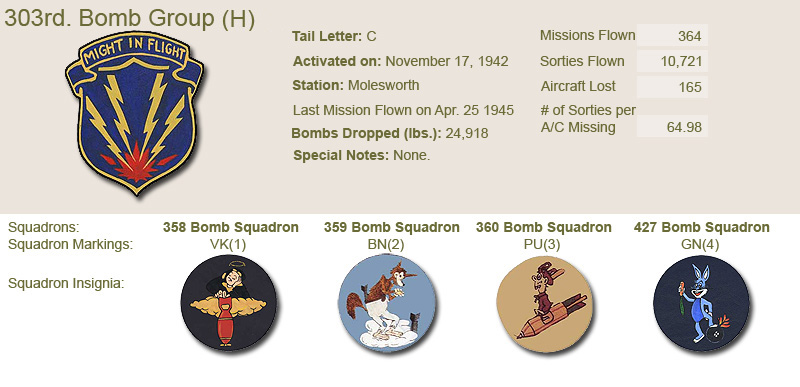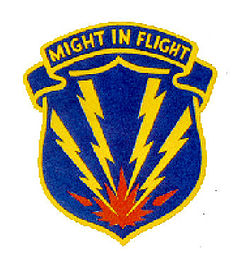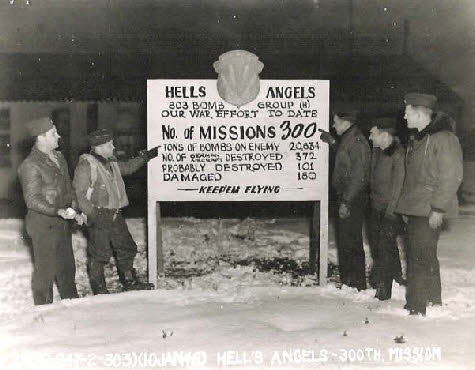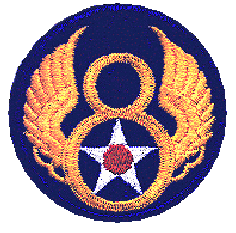



World War II:
The 303rd Bombardment Group (H) was constituted on 28 January 1942 at Savannah, GA,
was activated at Pendleton Field, Pendleton, OR, on 3 February 1942, and received
its initial staff and training at Gowen Field, Boise, ID, on 13 February 1942. Training
for its combat missions took place at Alamogordo Air Base, NM, and Biggs Field, TX.
On 23 August the ground echelon moved to Fort Dix, NJ, to board the Queen Mary for
overseas deployment. They arrived at Molesworth, England, on 9 September 1942. The
air echelon arrived in late October and the stage was set for entrance into combat.
The
first combat mission was flown on 17 November 1942, with a planned strike at the
St. Nazaire submarine pens, but weather obscured the target, resulting in a return
to base with bombs undropped. It was a disappointing beginning, but only the first
of 363 missions to come. Over the months and years that followed, lessons were learned,
equipment was improved, and the tale of Hell's Angels "Might in Flight" evolved.
First
targets were usually airfields and marshalling yards in France and the Low Countries.
Several targets in Paris were struck in 1943 and, although it was defended by about
250 flak guns, only one plane was lost in six attacks. The 303rd formations often
encountered the "Abbeville Kids," the yellow-nosed FW 190s flying out of the airfield
just north of Abbeville, France. Their attacks were in retaliation to the 303rd's
bombing of Abbeville on 10 July 1943. They didn't take kindly to our bombing and
took great joy in finding a 303rd BG formation.
Soon, many German targets were hit and, to mention a few, Mannheim and Ludwigshafen
were attacked 12 times with only five losses. The transport and industrial center
of Frankfurt was bombed nine times in 1943 and 1944, in which only three aircraft
were lost. The 15 August 1944 attack on the Wiesbaden airfield cost the group nine
bombers. Cologne rail lines and industry were the targets on 10 missions, including
the famous glide bomb attack. The largest marshalling yard in Germany, located at
Hamm, was hit six times and its flak defenses accounted for two aircraft down. In
the later stages of the war, the 303rd bombers struck industrial sites, transportation
hubs, and oil refineries at Munich, Magdeburg, Hamburg, Gelsenkirchen, Merseburg,
Leipzig, Essen, Schweinfurt. Bremen, Stuttgart, Kiel and Brunswick with increase
in efficiency and decreasing losses.
As part of the joint USAAF-RAF objective to eradicate
the "buzz bomb" threat, 303rd crews attacked 12 sites between 28 February and 30
August 1944 at altitudes of 12,000 and 14,000 feet. On 11 January 1944, leading the
First Division, the 303rd hit Oschersleben, Germany, after most of the 8th Air Force
and its fighter escort had aborted due to weather. The devastating strike was the
beginning of the end for the German Air Force, but cost 10 aircraft (42 altogether
in the First Division). For this valuable contribution to the war effort, the men
of the Hell's Angels Group, both air and ground echelons, wear the badge of a Distinguished
Unit Citation.
On 6 March 1944, the Group participated in one of the first strikes on Berlin. Later,
they carried their bombs as far east as Poland, where one of the most compact bombing
patterns of the war destroyed an industrial site. The 303rd was, of course, part
of the aerial support on D-Day, 6 June 1944. On that date, the crews flew three separate
missions between dawn and dusk in a ground support role rather than a strategic bombing
force. Bombing almost around the clock occurred in June when 29 missions and 1000
sorties were flown.
In tribute to one of the most famous Flying Fortresses of World War II, Hell's Angels
(#41- 24577), the 303rd Bombardment Group took its name, Hell's Angels. In the inventory
since the Group's beginning, this aircraft was the first heavy bomber in the 8th
Air Force to complete 25 missions.
The success of the 303rd Bombardment Group (H)
was not the result of any one person, aircraft, or unit. It was and is the story
of many individuals taking pride in their assigned duties and contributing the most
they could to the mission. Ground crews often worked on their "birds" with little
or no sleep to repair enemy damage and keep their charges armed and ready for the
next combat mission. The 303rd BG(H) effective intelligence staff was possibly unique
among 8th Air Force groups in that several of its members volunteered to fly combat
missions in order to gain first-hand experience and to provide more precise briefings
for the combat crews. The supplies - everything from aircraft parts and ammunition
to food and PX items - were available. thanks to the effort of support elements.
This was not an easy task in the early days, but the 303rd "conveyor belt" never
failed.
When the Hell's Angels Bomb Group was deactivated in Casablanca on 26 July 1945, it could look back to an outstanding record of several honors and "firsts" during its tour of duty:
First B-17 to complete 25 Eighth AF combat missions - Hell's Angels
First B-17 to complete 50 Eighth AF combat missions - Knockout Dropper
in tight competition
with S for Sugar and Hell's Angels
First B-17 to complete 75 Eighth AF combat missions - Knockout Dropper
First Eighth AF Bombardment Group to complete 300 missions from bases in England
Two combat crewmen were awarded the Congressional Medal of Honor
Four combat crewmen were awarded the Distinguished Service Cross Medal
An Eighth Air Force combat score of:
364 combat missions - the most flown by any B-17 Bomb Group
10,721 aircraft sorties
flown - the second highest in the Eighth Air Force
26,346 tons of bombs dropped -
the second highest in the Eighth Air Force
378 enemy aircraft destroyed - the third
highest in the Eighth Air Force
104 enemy aircraft probably destroyed - the third
highest in the Eighth Air Force
182 enemy damaged











